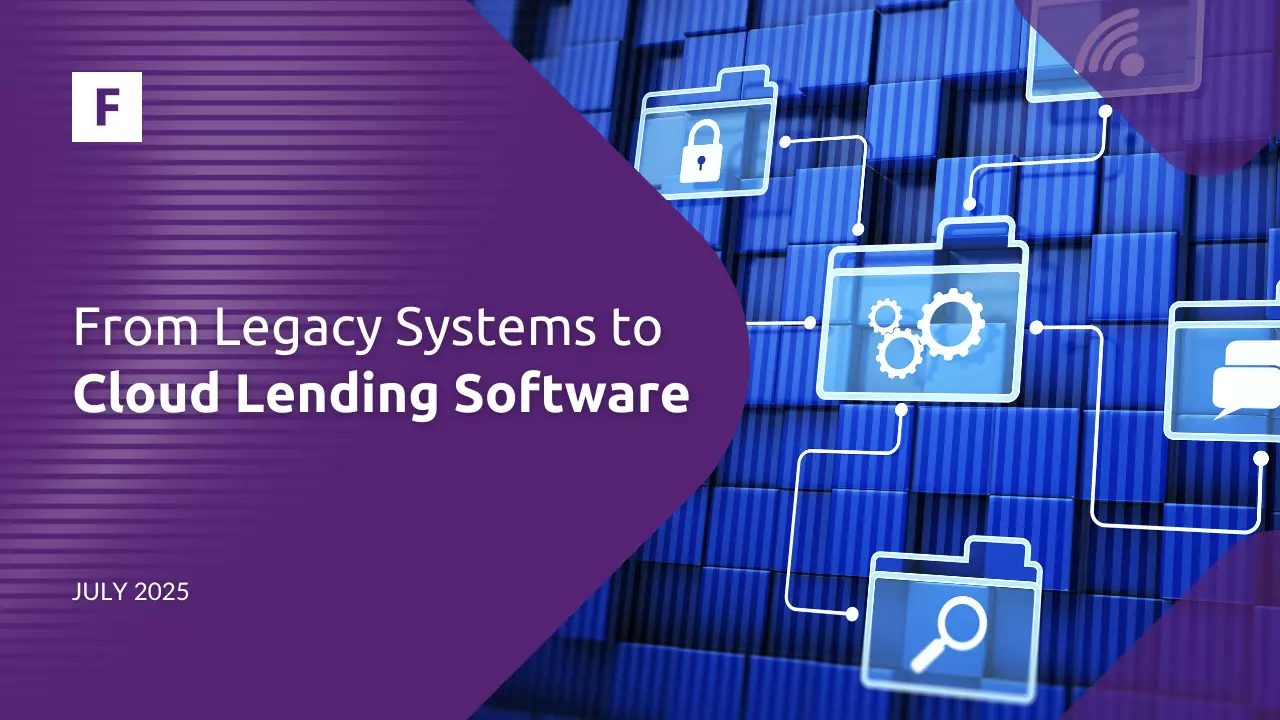Key Takeaways
Navigate the Digital Lending Landscape to leverage innovative operating models and technological advancements.
Leverage cloud-based platforms, SaaS models, AI tools & integrations for efficient loan origination & servicing with seamless customer onboarding.
Implement digital lending solutions carefully while prioritizing compliance and security measures for long-term success.
Navigating the Digital Lending Landscape
Digital lending platforms provide businesses with flexible and cost-effective solutions to streamline their loan processes. These modern options bring customers a tailored experience, while facilitating origination and servicing of various types of loans. Businesses can also benefit from improved speed in the digital arena since they are able to quickly launch new products on the market with rapid response times for quotes or closings. Focus is placed both on providing exceptional customer service but also ensuring that companies have access to advanced features for successful operations within this sector. Mordor Intelligence article about digital lending market size estimates that the digital lending market size is USD 453.32 billion in 2024, and is expected to reach USD 795.34 billion by 2029.
The Surge of Digital Lending Platforms
Digital lending platforms are experiencing strong growth due to several elements, such as improved operating models, technological advancements and a decreased cost of infrastructure. These solutions provide customers with a simplified approach that reduces the chance of mistakes or dissatisfaction. Digital lending platform market was valued at USD 12.2 billion in 2022, growing at a CAGR of 14.3% from 2023 to 2032. The market is expected to reach USD 46.4 billion by 2032 according to Brainy Insights. Banks have been taking advantage of the digitalisation trend by using core banking systems that support digital customer onboarding and loan product management. In addition the industry standard is to have a real-time credit decisions on their own products which can be created anytime anywhere & deliver timely responses to customers while keeping costs down.
Types of Digital Lending Solutions
Digital lending solutions provide various features which can benefit businesses in numerous ways. Best-in-class options enable customer digital onboarding, streamlined loan operations, allowing them to offer customised loan offers according to customers' credit score and background checks. Such platforms offer cloud services that allow lending companies to have a modular architecture for creating digital products as well as SaaS models with cost efficiency and scalability so businesses only pay for what they need. AI tools like Holistic AI support accurate risk assessment processes throughout decision-making stages. It's important to understand the advantages and limitiations of digital transformation before making the decisions.
Key Features to Look for in Digital Lending Software
When selecting a digital lending platform, it is essential to evaluate features such as integrated third-party services, data migration complexity, easy customer onboarding, and debt collection functions. Not only do these capabilities optimize the user experience, but also guarantee that your software can successfully control every step of the entire loan lifecycle from application to repayment and collection.
To understand how each feature contributes to an effective digital lending process, we must take time for a closer examination of these key elements.
Seamless Customer Onboarding and Experience
To ensure clients are delighted with their services, businesses need to have an efficient and intuitive onboarding process. Digital lending platforms can build a connection with customers by personalizing the experience while utilizing key components like state-of-the-art software for customer analytics optimization. Automation significantly enhances customer onboarding on digital lending systems resulting in faster loan application processing times and fewer errors throughout the loan lifecycle like mentioned in the Oracle Blog. By streamlining these processes seamlessly, more customers will be retained through the acquisition from excellent user experiences of such innovative digital solutions.
Loan Management Capabilities
Businesses can use digital lending software and its loan origination, underwriting, servicing, document management, and analytics capabilities to manage multiple types of loans while adapting to changing market conditions. Loan lifecycle automation such as application processing or risk analysis reduces manual effort and helps optimize operations for businesses that rely on the power of lending. These solutions provide flexibility to stay competitive amid varying financial landscapes. Their scalability allows companies an easier way to manage all aspects related to loan product offerings. Slava Podmurnyi from Visartech states that one of the important capabilities of a loan management system is servicing different loan types.
The Power of Cloud-Based Lending Platforms
Cloud technology has a lot to offer businesses that want to modernize their lending operations, including enhanced flexibility, scalability, and cost savings. By leveraging cloud-based platforms, companies can conveniently expand their activities by varying market requirements while also reducing expenditure on infrastructure upkeep. According to a research by the International Data Group, 69% of businesses are already using cloud technology in one way or another, and 18% confirmed they plan to implement cloud-computing solutions in the near future. SaaS models may provide additional monetary benefits associated with these services because lending software like Fintech Market covers over 30 markets with the needed requirements. These advantages of the cloud will be discussed more fully below.
Flexibility and Scalability at Your Fingertips
The key advantage of using cloud technology for businesses is scalability, enabling companies to expand their operations into new markets and adjust products depending on different market and customer needs. Cloud-based lending solutions offer several benefits such as faster launching of loan services, shorter customer onboarding time, and optimizing expenditure costs while providing the necessary international reach required by organizations. The use of such technologies allows lending companies to benefit from these features thereby allowing smooth scaling to meet market demand or economic factors efficiently.
Reducing Costs with SaaS Models
Digital lending has become a cost-effective choice for businesses who want to offer their clients digital lending services that could be accessible via mobile phone or desktop. The SaaS model eliminates the need to develop the system internally or purchase it externally like mentioned in SaaSolic article, thus reducing both upfront costs as well as ongoing maintenance expenses and allowing lenders to improve operational efficiency.
The flexibility of this subscription-based service provides pay-as-you-go pricing which makes it even more attractive by lowering initial investments along with reduced continuing costs. Fintech Market offers monthly pricing that is based on the exact features the client needs from the system. All these features make SaaS an ideal solution sought after by those looking at digitizing their loan offerings or expanding existing ones already available on offer.
Enhancing Efficiency Through Automation and AI
In digital lending, automation and AI can be a real game-changer by providing increased efficiency in processes as well as improving risk assessment and decision-making. Automation of various tasks along with advanced data analysis has the potential to reduce mistakes, and speed up loan approvals while simultaneously optimizing the experience for both lenders and borrowers alike.
Furthermore, a modern loan origination system has a list of external integrations that the system already covers. Some of the integrations are global ones, but some of them are specific to one market. Having those integrations already in the system makes it easy for the lenders to use them. That integration usually cover credit bureaus for risk management and communication gateways for CRM functions.
Streamlining Processes with Automation
When it comes to digital lending operations, automation can be a great boon. It speeds up loan processing and increases efficiency by eliminating the possibility of errors associated with manual processes. Automated checks and surveillance also allow for irregularities in these transactions to be detected quickly while reducing the risk that erroneous data entry or other human mistakes could occur during lending activities. With that said, automation eliminates the need for hiring hundreds of employees to do the previous manual work.
Leveraging technology assists firms in providing more secure yet quicker financial services through digital platforms thanks to its capability of improving accuracy as well as boosting overall performance within digital lending practices without sacrificing safety measures taken into consideration firstly such as minimizing risks present when dealing with loans and their related processes.
Integrations and Ecosystems: Expanding Your Lending Reach
The whole lending ecosystem that consists of different third-party integrations plays an important role for lending businesses to extend their reach with the help of APIs and partnerships. By connecting digital lending platforms to third-party services, companies can improve the range of their loan offerings as well as amplify their capabilities digitally while reinforcing platform performance in terms of features. Through integration and leveraging API power, firms can increase borrowing possibilities significantly, which enhances service delivery associated with the digital experience they offer clients daily.
APIs: The Connective Tissue of Digital Lending
Businesses can use APIs to accelerate their app development process and increase digital access while allowing for smooth integration with outside services that enhance the lending platform's capabilities. By harnessing the power of APIs, businesses can create connections and interact conveniently with core lending systems or fintechs. This means borrowers and lenders on the borrowing platform can reap all the benefits from third-party service providers as they have direct access to these features as well as associated data. Ultimately, this increases customer satisfaction regarding any type of lending services supplied by such platforms online.
Implementing Your Digital Lending Solution
Digital lending solutions require meticulous preparation with efficient data transfers and reliable compliance/security procedures in place. Adequately preparing staff, migrating data properly, and minimizing the disturbance to already-existing operations is key for a successful implementation of digital lending.
The need for seamless transition strategies along with all mandatory compliance/safety measures required during an effective deployment will be outlined below.
Smooth Transition Strategies
Businesses should ensure a smooth transition to digital lending solutions to improve customer satisfaction and efficiency. IBM claims in their article about benefits of cloud computing that efficiency is mainly a combination of accessibility, speed to market and data security. This involves designing strategies around training personnel, moving data seamlessly, and making minimal changes to existing processes. A successful implementation requires setting up objectives specific to the new platform along with assessing current resources available before creating strong communication paths between departments. By investing in an efficient shift strategy from traditional processes towards modernizing through technology businesses can achieve higher levels of success when incorporating their chosen digital lending solution or platform into operations.
Compliance and Security Measures
Businesses need to build trust with customers by prioritizing security and compliance when it comes to digital lending. Key features that should be implemented include encryption, secure data storage within cloud platforms, as well as regular audits for vulnerabilities in the system. Businesses must adhere to relevant industry regulations such as securing informed consent from borrowers or enabling them to manage their data securely. With these measures put into place, a strong and reliable digital lending platform can be maintained over time while protecting customer information along the way. RapidScale results show that 94% of businesses saw an improvement in security after starting to use cloud solutions, and 91% said the cloud makes it easier to meet government compliance requirements.
Case Studies: Transformational Success Stories
Hoovi is an Estonia-based SME lender specializing in financial products for small and medium-size businesses. Their product range covers a business credit line, small investment loans, and a flexible payment solution for partners' B2B customers. To support their growth and address market challenges, Hoovi implemented Fintech Market's loan management system.
The impact of these advancements has had an impressive effect on Hove and could also affect financial services organizations around the world. Enhancing effectiveness with increased accuracy and improved speed are just some benefits associated with leveraging technology within the industry's operations. By looking at case studies that showcase how different types of companies used digital lending solutions successfully it becomes apparent that business leaders should look into them as well - commercial lending breakthroughs can be achieved together with innovations benefiting consumer loans through modern strategies involving online tools or software-based products.
Consumer Lending Breakthroughs
Digital lending has revolutionized consumer lending, providing businesses with the opportunity to meet their customers' needs efficiently and cost-effectively. Through advances such as automated processes, reduced processing times, access to credit for consumers on a larger scale than ever before -and much more -, market performance is improved while reducing IT infrastructure costs simultaneously.
The implementation of digital loans greatly reduces the time consumed when making payments by customers or granting them new lines of credit. Thus leveraging business efficiency even without compromising scalability potentials whatsoever. Businesses have also benefited from this digital transformation --reducing manual operations all over -- allowing them to better manage customer relationships by offering up specialized services tailored specifically towards each user profile's needs using tailor-made software algorithms that integrate within these platforms themselves seamlessly.
Overall conclusions show how embracing the use of advanced digital loan solutions not only brings forth significant benefits but at the same pace helps open channels into broader financial inclusion opportunities provided they are properly administered given its security measures taken post installation thanks to continuing advancements.
Summary
Digital lending solutions provide businesses with a powerful way to make their processes more efficient and expand their presence in the market. By using these platforms, companies can benefit from cloud-based tools such as automation and AI that allow for greater scalability and better customer experience. With the right digital lending solution selected and implemented correctly, businesses have an edge over competitors in terms of performance due to harnessing all possibilities of digital financing opportunities available today.
Frequently Asked Questions
What are the key features to look for in digital lending software?
When evaluating digital lending software, it is important to consider key features such as customer onboarding that's straightforward and effortless, loan management abilities in their entirety, plus compatibility with external services.
How can cloud-based lending platforms benefit businesses?
Cloud-based lending can offer businesses advantages such as scalability, cost efficiency, and increased flexibility to help modernize their operations. This is why many choose this platform to improve how they do things.
What role does automation play in digital lending?
Digital lending is made more efficient and accurate by the use of automation, which makes operations simpler while allowing for improved risk assessment and decision-making. Automation has become a vital part of this process to guarantee accuracy, enhance efficiency throughout all stages of the lending process, and reduce any possible mistakes.
How can businesses expand their lending reach through integrations and ecosystems?
Businesses can extend their lending capabilities and reach customers more efficiently with integrations and ecosystems. Key components in this approach, such as APIs and partnerships, permit companies to boost the usefulness of their borrowing platform, thus allowing for improved customer access.
About Fintech Market
Fintech Market (FTM) operates in the lending software market, offering a comprehensive SaaS-based loan management system for financial service providers. It includes essential features such as CRM, KYC, risk management, and debt management for loans, deposits, current accounts, and investments. With tailored solutions to optimize their operations, FTM serves neobanks, SMEs, car leasing companies, and buy-now-pay-later companies in the EU, Mexico, and Indonesia.







